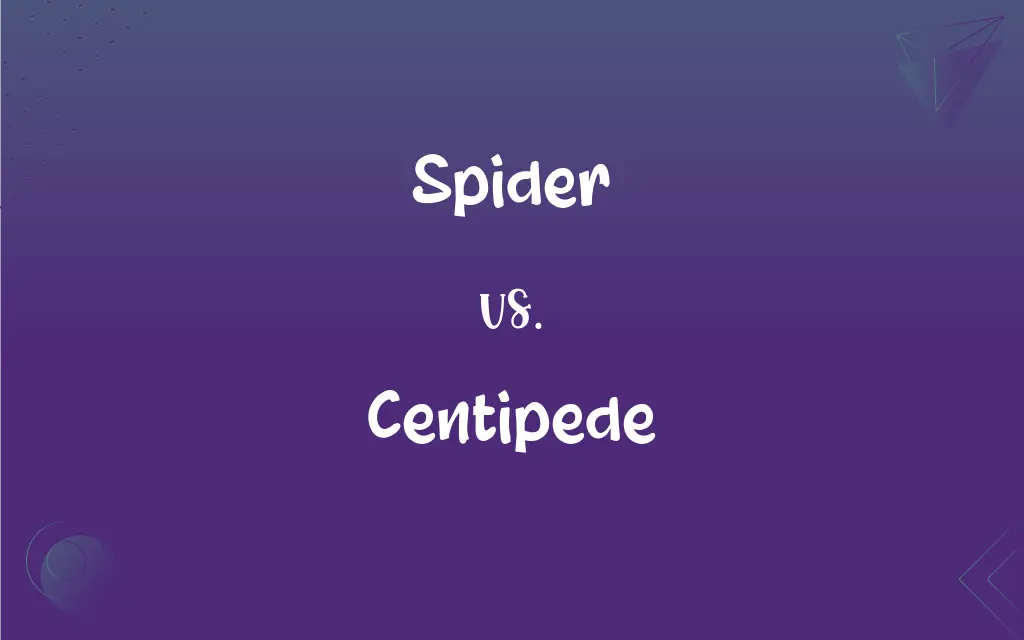Spider vs. Centipede: What's the Difference?
Edited by Aimie Carlson || By Janet White || Updated on October 2, 2023
"A spider is an eight-legged arachnid, usually spinning webs, while a centipede is a multi-legged myriapod with one pair of legs per body segment."

Key Differences
Spiders and centipedes are both arthropods, but they belong to different classes within the animal kingdom. A spider is a member of the class Arachnida and typically has eight legs, two body segments, and can produce silk. In contrast, a centipede belongs to the class Chilopoda and has a more elongated body with one pair of legs per body segment, amounting to a variable number of legs depending on the species.
While spiders are well-known for their ability to spin webs using silk produced by their spinnerets, centipedes do not have the ability to produce silk and do not create webs. Instead, centipedes are swift movers and are known for their speed and agility. Spiders generally consume a diet of insects and other small creatures that they trap in their webs, while centipedes are carnivorous, preying on a variety of smaller animals, using their venomous claws located just behind the head to paralyze their prey.
The appearance and anatomy of spiders and centipedes are quite distinct. Spiders have two main body parts: the cephalothorax and the abdomen. The cephalothorax bears the legs, eyes, and mouthparts. Centipedes have a segmented body, and each segment bears one pair of legs. The number of segments, and thereby the number of legs, varies widely among different centipede species.
The habitats of spiders and centipedes can overlap, as both can be found in a variety of environments ranging from forests to deserts. However, spiders are more likely to be found suspended in webs or hiding in secluded locations, while centipedes are more ground-oriented and may be found under rocks, leaf litter, or within soil. Both are predominantly nocturnal, preferring to hunt or be active during the night.
Comparison Chart
Class
Arachnida
Chilopoda
ADVERTISEMENT
Body Segments
Two: Cephalothorax and Abdomen
Many, each with one pair of legs
Legs
Eight
Variable, one pair per segment
Web-Spinning
Yes, typically can spin webs
No, does not spin webs
Diet
Predominantly insects and other small animals
Carnivorous, preys on various smaller animals
Spider and Centipede Definitions
Spider
An eight-legged arachnid that can spin silk.
The spider spun a intricate web between the branches.
ADVERTISEMENT
Centipede
An arthropod that may have a variable number of legs depending on the species.
This species of centipede has fewer legs than its larger, tropical cousins.
Spider
A small to large-sized arthropod that often catches prey in webs.
A spider waited patiently in the center of its web for prey to arrive.
Centipede
A swift, elongated arthropod with one pair of legs per body segment.
The centipede raced across the forest floor, disappearing under a leaf.
Spider
A nocturnal arthropod that may exhibit various colors and patterns.
The brightly colored spider was a species known for its vivid markings.
Centipede
A carnivorous myriapod with a segmented body.
The centipede captured its prey using its venomous claws.
Spider
Any of numerous arachnids of the order Araneae, having a body divided into a cephalothorax and an abdomen, eight legs, two chelicerae that bear venom glands, and two or more spinnerets that produce the silk used to make nests, cocoons, or webs for trapping insects.
Centipede
A ground-dwelling creature often found under rocks and leaf litter.
I lifted the rock and uncovered a centipede.
Spider
One that resembles a spider, as in appearance, character, or movement.
Centipede
A nocturnal hunter preying on smaller animals.
The centipede roamed the night soil, hunting for its next meal.
Spider
A program that automatically retrieves webpages and follows the links on them to retrieve more webpages. Spiders are used by search engines to retrieve publicly accessible webpages for indexing, and they can also be used to check for links to webpages that no longer exist. Also called crawler, search bot.
Centipede
Any of various predatory arthropods of the class Chilopoda, having a long flattened body composed of segments, each bearing a pair of jointed appendages. The appendages of the foremost body segment are modified into venomous claws. Also called chilopod.
Spider
New England, Upper Northern, & South Atlantic US See frying pan.
Centipede
Any arthropod of class Chilopoda, which have a segmented body with one pair of legs per segment and from about 20 to 300 legs in total.
Spider
A trivet.
Centipede
A species of the Myriapoda; esp. the large, flattened, venomous kinds of the order Chilopoda, found in tropical climates. they are many-jointed, and have a great number of feet.
Spider
Any of various eight-legged, predatory arthropods, of the order Araneae, most of which spin webs to catch prey.
Centipede
Chiefly nocturnal predacious arthropod having a flattened body of 15 to 173 segments each with a pair of legs the foremost being modified into poison fangs
Spider
A program which follows links on the World Wide Web in order to gather information.
Spider
A float drink made by mixing ice-cream and a soda or fizzy drink (such as lemonade).
Spider
An alcoholic drink made with brandy and lemonade or ginger beer.
Spider
(slang) A spindly person.
Spider
(slang) A man who persistently approaches or accosts a woman in a public social setting, particularly in a bar.
Spider
A stick with a convex arch-shaped notched head used to support the cue when the cue ball is out of reach at normal extension; a bridge.
Spider
A cast-iron frying pan with three legs, once common in open-hearth cookery.
Spider
(cooking) Implement for moving food in and out of hot oil for deep frying, with a circular metal mesh attached to a long handle; a spider skimmer
Spider
(cycling) A part of a crank, to which the chainrings are attached.
Spider
Heroin.
Spider
(music) Part of a resonator instrument that transmits string vibrations from the bridge to a resonator cone at multiple points.
Spider
A skeleton or frame with radiating arms or members, often connected by crosspieces, such as a casting forming the hub and spokes to which the rim of a fly wheel or large gear is bolted; the body of a piston head; or a frame for strengthening a core or mould for a casting.
Spider
A soft-hackle fly.
Spider
(sports) The network of wires separating the areas of a dartboard.
Spider
(maths) A spider graph or spider tree.
Spider
(obsolete) A type of light phaeton.
Spider
(photography) A support for a camera tripod, preventing it from sliding.
Spider
(lawn bowls) A competition in which several participants are spread evenly around the edges of the green, who all make one bowl towards the central jack at the same time; the winner being the person whose bowl ends up closest to the jack.
Spider
To move like a spider.
Spider
To cover a surface like a cobweb.
Spider
To follow links on the World Wide Web in order to gather information.
The online dictionary is regularly spidered by search engines.
Spider
Any one of numerous species of arachnids comprising the order Araneina. Spiders have the mandibles converted into poison fangs, or falcers. The abdomen is large and not segmented, with two or three pairs of spinnerets near the end, by means of which they spin threads of silk to form cocoons, or nests, to protect their eggs and young. Many species spin also complex webs to entrap the insects upon which they prey. The eyes are usually eight in number (rarely six), and are situated on the back of the cephalothorax. See Illust. under Araneina.
Spider
Any one of various other arachnids resembling the true spiders, especially certain mites, as the red spider (see under Red).
Spider
An iron pan with a long handle, used as a kitchen utensil in frying food. Originally, it had long legs, and was used over coals on the hearth.
Spider
A trevet to support pans or pots over a fire.
Spider
A skeleton, or frame, having radiating arms or members, often connected by crosspieces; as, a casting forming the hub and spokes to which the rim of a fly wheel or large gear is bolted; the body of a piston head; a frame for strengthening a core or mold for a casting, etc.
Spider
Predatory arachnid that usually has silk-spinning organs at the back end of the body; they spin silk to make cocoons for eggs or traps for prey
Spider
A computer program that prowls the internet looking for publicly accessible resources that can be added to a database; the database can then be searched with a search engine
Spider
A skillet made of cast iron
Spider
An invertebrate with two body segments and multiple eyes.
The spider scurried away, seeking refuge under a rock.
Spider
A creature that may inject venom through fangs to subdue its prey.
The spider captured and envenomated the fly that flew into its web.
FAQs
Is a centipede carnivorous?
Yes, a centipede is carnivorous, preying on smaller animals.
Do centipedes have venomous claws?
Yes, centipedes have venomous claws to capture prey.
Can spiders be found worldwide?
Yes, spiders can be found in various habitats worldwide.
How many legs does a spider typically have?
A spider typically has eight legs.
Does a centipede have segments?
Yes, a centipede has a segmented body with each segment having one pair of legs.
Are spiders invertebrates?
Yes, spiders are invertebrates.
Are spiders usually venomous?
Many spiders are venomous but most are harmless to humans.
Are centipedes nocturnal?
Yes, centipedes are generally nocturnal.
Do centipedes have antennae?
Yes, centipedes have a pair of long antennae.
Can spiders spin webs?
Yes, many spiders can spin webs.
Can centipedes have a varying number of legs?
Yes, different species of centipedes can have a varying number of legs.
Do all spiders spin webs?
No, not all spiders spin webs; some are hunters, and others burrow.
Do spiders have two body segments?
Yes, spiders have two main body segments: the cephalothorax and the abdomen.
Can centipedes move swiftly?
Yes, centipedes are known for their speed and agility.
Can some spiders be kept as pets?
Yes, some species of spiders, like tarantulas, are kept as pets.
Can centipedes be found in various habitats?
Yes, centipedes can be found in a variety of habitats ranging from forests to deserts.
Do spiders consume insects?
Yes, spiders predominantly consume insects and other small creatures.
Are spiders predominantly nocturnal?
Many spiders are nocturnal, but some are active during the day.
Can centipedes have more than 100 legs?
Despite the name, some species of centipedes can have more than 100 legs.
Are centipedes arthropods?
Yes, centipedes are arthropods.
About Author
Written by
Janet WhiteJanet White has been an esteemed writer and blogger for Difference Wiki. Holding a Master's degree in Science and Medical Journalism from the prestigious Boston University, she has consistently demonstrated her expertise and passion for her field. When she's not immersed in her work, Janet relishes her time exercising, delving into a good book, and cherishing moments with friends and family.
Edited by
Aimie CarlsonAimie Carlson, holding a master's degree in English literature, is a fervent English language enthusiast. She lends her writing talents to Difference Wiki, a prominent website that specializes in comparisons, offering readers insightful analyses that both captivate and inform.































































